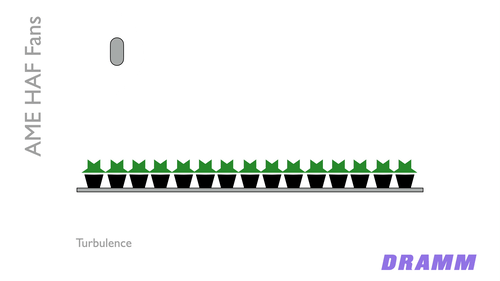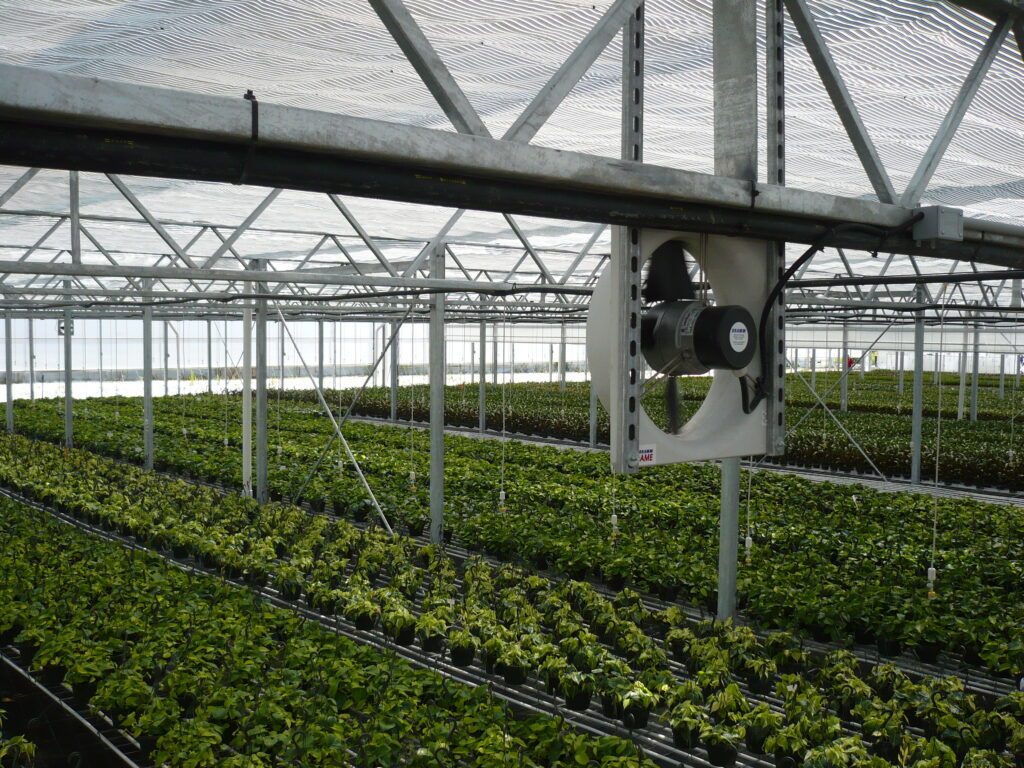Uneven Plant Growth
Are there areas of your greenhouse or growing operation where plant height is not uniform and plant growth is not even? Air movement may be the reason.
Even after investing in an irrigation system that provides the same water and fertilizer to each plant, it is possible that those plants may transpire at different rates, causing the plants to take up different amounts of water. If the air movement is uneven, it will cause uneven transpiration from plant to plant.
Water moves from the roots, through the plant, to be exhausted from the stomata during the process of photosynthesis. This water transports nutrients as it flows, aiding in plant growth. As the moisture is transpired, it forms a microclimate around the leaves, increasing the vapor pressure surrounding the plant. This pressure decreases transpiration. Generally, this is localized and air movement will help remove this moisture layer. Proper air movement should focus on the even removal of this moisture layer and the homogenization of the humidity, temperature and CO2 in the greenhouse.
Air moving over the plant surface will move this moisture away from the plant. However, different air speeds can have a different effect from plant to plant. If some plants encounter higher air speeds, more of their moisture layer can be diffused and drying can result. The goal of a well designed air flow system is to evenly move the air throughout the facility so that the plants see similar air speeds throughout the crop.
Momentum as a Goal
With poorly designed systems or fans that run too fast, speeds are uneven, causing some plants to transpire more than others. Some air movement systems focus on fan speeds that are too high. Trying to achieve higher air speeds evenly across a crop is difficult. As the air moves further away from the fan, speeds reduce quickly as the air encounters resistance. Momentum can replace speed. By starting slower, with more directional air movement, even air flow can be achieved by creating a stable momentum of air throughout the growing space.
Better Fans

Most horizontal air flow fans are a motor and blades surrounded by a cage to protect fingers and birds. Only the blade angle determines the direction of the air from the fan. These fans often run fast and throw air out in a wide pattern creating a great deal of turbulence. Turbulence, by nature, is variable. Air speeds change throughout the pattern. This turbulent air pattern contacts the plants at different speeds throughout the crop. Areas beneath and in front of the fans see faster air speeds than further away.
Dramm AME fans use a shrouded design with an efficient, long-life motor. The shroud allows for air to be thrown forward, not outward. The air moves above the crop, entraining the remaining air in the greenhouse to move with it over time, building momentum. As a result, fewer fans may be required to do a better job. The efficient motor design uses less energy and creates less noise than standard fan motors. The sealed motor lasts longer than vented fan motors.
Reduced Speed
Each Dramm AME System includes speed control. For even air flow, lower speeds are better. Gentler air speeds have less variance over the crop and build more consistent momentum throughout the space. However, air speeds required change with different crops, plant density, structural interference and air space above the crop. For this reason, variable speed is preferable to winding the motors for a specific RPM. This allows the grower to select the speed that best suits the crop.
With a variety of speed control sizes, Dramm typically uses one controller per zone or growing area. Most of these controllers can be connected to a climate control computer for automated speed regulation.
Properly Designed System
Fans placed improperly or without attention to engineering specifications can cause more turbulence and variance in the crop. To ensure that your air flow is optimal for your crop and facility, Dramm designs each system, providing a layout of the growing space and the locations and size of the fans.
Many HAF fans do not offer more than a brochure to guide the grower in placement. Dramm takes into account, the dimensions of the space, the height above the crop, the heating and mechanicals in the space and other factors that will increase resistance. Each will have an impact of the overall air flow, fan sizing, placement and number of fans required.
Better Air Movement!
Combining shrouded fans with slower air speeds and a proper layout, Dramm can achieve a more even climate and more consistent plant growth. Momentum allows for the air to move consistently throughout the growing space while minimizing variance in speed that can cause uneven crop drying.
Dramm Can Help!
Dramm’s team of experts can work with you to design an air flow system to homogenize temperature, CO2 and humidity while evening transpiration in the crop. Contact your Dramm representative or submit a quote request online.

